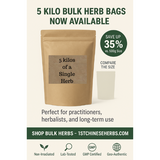

Plum Flower Powders
Andrographis Herb Powder - Chuan Xin Lian Bulk Bag
Andrographis Powder 5 Kilogram Bulk Bag (1 single bag) Why Is Andrographis Revered in Traditional Chinese Medicine?

Supports Digestive Health
Anti-Parasitic Properties
Boosts Immune Function
Anti-Inflammatory Effects
Promotes Detoxification
Balances Qi in TCM
Adaptogenic Benefits
Rich in Nutrients and Bioactive Compounds
The thunderball fungus, a captivating organism that has intrigued mycologists and nature enthusiasts for centuries, has a rich and mysterious history. First discovered in the dense forests of Southeast Asia during the late 18th century, this peculiar fungus quickly caught the attention of early explorers and naturalists. Its unique appearance and explosive spore dispersal mechanism led to its colloquial name, which has endured to this day.
Thunderball Fungus, also known as Scleroderma citrinum, is a type of fungus that belongs to the Sclerodermataceae family. It is commonly found in temperate regions around the world, often growing in woodland areas with rich organic soil.
Thunderball Fungus typically has a round or slightly irregular shape, with a rough and thick outer skin. The color of the fungus can range from pale yellow to brown, and it can grow to be several centimeters in diameter.
Thunderball Fungus is often found growing on the forest floor, particularly in areas with decaying organic matter such as fallen leaves and wood. It can be identified by its round shape, rough texture, and distinctive coloration.
Thunderball Fungus is an important decomposer in forest ecosystems, breaking down organic matter and recycling nutrients back into the soil. It forms symbiotic relationships with certain tree species, helping them to absorb essential nutrients from the soil.
Common Names: Thunderball Fungus, Thunder ball fungus, Omphalia
Botanical Name: Omphalia lapidescens fungus
Chinese / Pin Yin Name: Lei Wan
Omphalia Dosage: Consult your healthcare provider for your correct dose.
Omphalia Precautions: Do not take if nursing or pregnant.
Omphalia is a traditional Chinese medicinal herb to rid intestinal parasites.
Omphalia Properties: Bitter, cold, slightly toxic
Omphalia Channels / Meridians: Stomach
References
https://tcmwiki.com/wiki/lei-wan
https://www.ncbi.nlm.nih.gov/pubmed/29541181
https://www.ncbi.nlm.nih.gov/pmc/articles/PMC5835924/
https://www.acupuncturetoday.com/herbcentral/omphalia.php